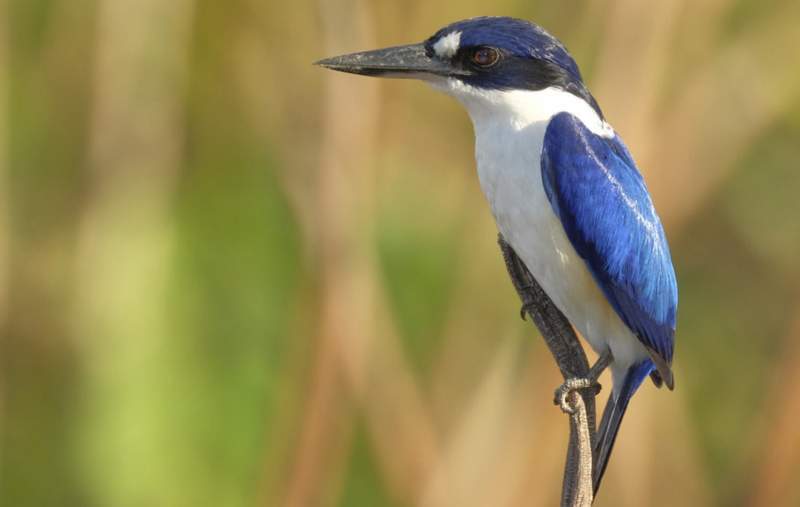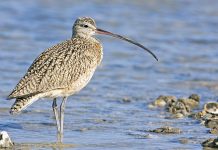Forest Kingfisher (Todiramphus macleayii) is also known as Macleay’s Kingfisher, Blue Kingfisher, and Bush Kingfisher. Forest Kingfisher call is harsh trilling chatter of repeated notes, t’reek t’reek. Also, similar high-pitched repeated whistles. This kingfisher is normally silent except when breeding.
The size of forest kingfisher is about 190-220 mm in length. The male kingfisher head is dark royal blue with white spot on each side of forehead; broad black stripe from base of bill through eyes to ear coverts. A white collar at back of neck. Back royal blue, tinted deep turquoise-blue to turquoise-green. Tail is royal blue above, black to dusky grey below.
Wings are royal blue, flight feathers are duskier with broad white band on inner webs; underwing coverts white. Underparts are white, usually washed with buff on thighs. Eye deep brown. Bill black, with pale flesh base to mandible. Feet are slate-grey to black. The female bird back and neck blue. The immature bird is like adults but slightly duller, with forehead and shoulders scalloped faintly white, and breast scalloped faintly black. Immature males have an indistinct, blue-mottled white collar.

The bird lays 4 to 9 eggs, which are smooth slightly glossy white; oval to almost spherical, about 25 x 21 mm. Incubation duties are done by both sexes. Nesting and breeding occur in late August-December. Usually two broods in a season. Nest a burrow in a termite nest 2-15 meters above ground in a tree; sometimes in hollow limb or in earth between roots of fallen tree. Burrow ends in a small egg chamber.
In dry plains and downs at the head of the Gulf of Carpentaria, Forest Kingfishers appear to be divided into two populations that are slightly different in appearance and habits. A small, isolated breeding population of birds lives east of the McArthur River in Arnhem Land. Their backs are deep blue, and their wings are white, very similar to those of an Arnhem Land resident bird. Most birds of the more southern populations migrate north during winter to north-central Queensland and New Guinea and return during the spring and summer to breed in eastern Australia. They have a turquoise back and smaller white wings bar. There is a moderate abundance of forest kingfishers.
It is often found in the same forests and woodlands as the Sacred Kingfisher and Yellow-billed Kingfisher, but is easily identified by its blue upperparts, gleaming white underparts, and white ‘dollars’ on its wings in rapid, direct flight. Forest Kingfishers often sit motionless on telegraph wires or bare branches, staring intently at their prey after breeding, alone, in pairs, or in loose groups.

Beetles, bugs, spiders, grasshoppers, and small reptiles, frogs, and worms are some of the invertebrates that it feeds on. It rarely feeds on water. In order to catch prey, it plunges down, grasps it in its bill, and then returns to its perch to swallow it. Small pellets are formed from indigestible parts. When breeding, the males advertise their territory by calling and tail-raising in concert, and by a display involving much fanning of the tail. Both sexes excavate the nest burrow. The birds select a site such as a termite nest in a tree-and open up a hole in it by flying at it head on, with such force that on rare occasions they die from the impact.
They use their bills as picks to dig out the burrow, which may be only a few centimeters long. Nest sanitation is aided by the fact that the floor of the nesting chamber at the end of the burrow is only a little below the entrance level; the nestlings eject their droppings-which they do with great force-through the burrow into the open. Both sexes incubate and feed the young, and defend the nest aggressively. As far as distribution is concerned, it is found in open forests, woodlands and their edges in Arnhem Land and northeastern Australia from Cape York Peninsula south to the Hunter Valley, vagrants reach Victoria. So far, there are two races.

Read More: Azure Kingfisher – Nature’s Living Jewel in Magnificent Detail






